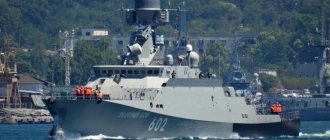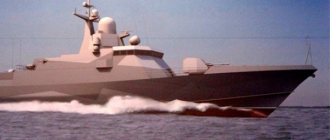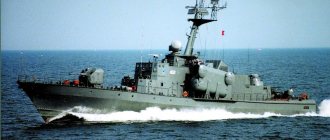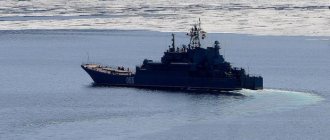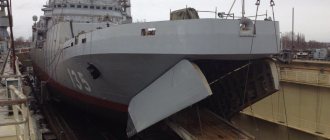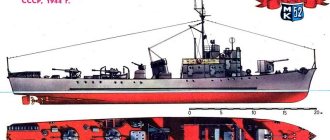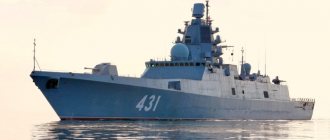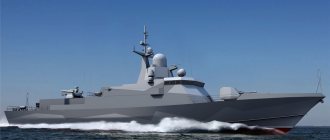In 2014, an event occurred whose importance for the Russian Navy is difficult to overestimate. To celebrate Russian Navy Day, domestic shipbuilders handed over to the sailors two new combat units - small missile ships of Project 21631 "Buyan-M", which were named in honor of the ancient Russian cities "Grad Sviyazhsk" and "Uglich". They became the first signs of a whole series of ships that Russian sailors expect to receive by 2022.
Of course, these ships with a displacement of less than one thousand tons do not inspire such respect as huge cruisers or nuclear missile carriers. But in the future they will undoubtedly play an important role in protecting the maritime borders of our Motherland.
Project 21631 is a series of small multi-purpose missile and artillery ships of the river-sea class. With a displacement of 950 tons, a shallow draft and rather low sides, it’s hard to dream of conquering the ocean spaces - the ships of the Buyan-M project were initially conceived for service in the waters of closed seas, of which there are three in Russia: Azov, Caspian and Black. Thanks to the presence of water-jet propulsion, Buyany-M are capable of operating in river mouths and in shallow seas.
They differ from their prototype - the Project 21630 artillery boat - by almost twice the displacement and the presence on board of a powerful missile system that allows them to strike at surface and ground targets.
Their main task is to protect the economic zone of the state, but the Buyanov weapons complex gives these vessels much broader capabilities. This was clearly demonstrated on October 7, 2015, when three ships of this project from the Caspian Sea launched a missile attack on targets located in Syria.
Specialists from the Zelenodolsk Design Bureau worked on the development of this project; it was supported by the 1st Central Research Institute of Moscow Region. The first ship of the Grad Sviyazhsk series was laid down at the Shipyard named after. Gorky on August 27, 2010, its launch took place at the beginning of 2013.
At the end of 2015, the fifth MRK of this series, the Serpukhov ship, was accepted into the fleet. Currently, Vyshny Volochek, the sixth RTO of this project, is undergoing state tests.
In total, thirteen Buyanov-Ms are planned to be transferred to the Russian fleet. Currently, the Shipyard named after. Gorky is building five RTOs, and a contract has already been signed between the enterprise and the Ministry of Defense for one more ship. Moreover, the last three ships of this series will have a more powerful weapon system - they are planned to be equipped with a new radar and Pantsir-SM air defense system, which will significantly increase the level of protection of the ships from threats from the air.
History of the creation of the Buyan-M MRK
The history of Project 21631 began in August 2002, when it was decided to build seven similar ships to strengthen the Caspian flotilla. A tender was announced, in which nine Russian shipbuilding enterprises took part. The winner was the Zelenodolsk plant named after. Gorky. On May 28, 2010, a contract was signed between him and the Ministry of Defense for the construction of five ships of this project.
The ship was initially developed taking into account the characteristics of the Volga delta and the Caspian Sea. The cruising range of the MRK was designed in such a way that it could make long journeys along the entire length of the river. It was planned to build up to ten ships of this project to strengthen the Caspian Flotilla and the Black Sea Fleet. Then the number 9 RTOs appeared in the media - six of which were supposed to be part of the Black Sea Fleet, and three were to go to the Caspian Sea.
The lead ship "Grad Sviyazhsk" was laid down with great fanfare on August 27, 2010, and a year later, with an interval of one month, the construction of two small missile ships began at once - the ships "Veliky Ustyug" and "Uglich". The first two ships of the series were launched in March 2013 and, after successful completion of mooring tests, were sent to Astrakhan, the main base of the Caspian flotilla. Having successfully passed state tests, both ships were accepted into the fleet in July 2014.
In 2012 and 2013, the ships “Green Dol”, “Serpukhov” and “Vyshny Volochek” were laid down - all of them have already been launched and accepted or are preparing to join the Russian Navy.
Currently on the stocks of the Shipyard named after. Gorky's ships "Orekhovo-Zuevo", "Ingushetia", "Grayvoron" and "Naro-Fominsk" are in varying degrees of readiness. It is planned that all of them will be part of various Russian fleets by 2022.
In 2014, after the adoption of anti-Russian sanctions, the German company MTU refused to supply engines for new ships of the Buyan-M project. However, this did not become a disaster for the project - a replacement was found quite quickly. For the next Buyanov-M, the power plant will be manufactured in Russia, most likely using Chinese components. In this regard, the St. Petersburg and OJSC Kolomensky Plants are most often named.
In 2016, a contract was signed between the Russian military department and shipbuilders for the construction of three additional ships of this series. Moreover, some changes will be made to the composition of their weapons. It is possible that the construction of this type of MRK will continue and in the future they will be part of other fleets, for example, the Northern or Pacific.
Meet: "Grad Sviyazhsk"
The small missile ship (SMR) "Grad Sviyazhsk", built by the Zelenodolsk Shipyard, was towed along the Volga to Astrakhan at the end of June this year and moored at the base of the OVR ships of the Caspian flotilla. This combat unit is still in the testing stage. Our correspondent visited the new ship. I couldn’t wait to look with my own eyes at the “Grad Sviyazhsk”, which our newspaper wrote about so often. After all, this is the first-born, that is, the lead ship of Project 21631 (code “Buyan-M”).
Our information
The lead ship of Project 21631 received its name “Grad Sviyazhsk” in honor of the settlement of Sviyazhsk, in the Zelenodolsk region of the Republic of Tatarstan. The history of this town is covered in legends. According to one of them, Sviyazhsk was built in 1551 by Ivan the Terrible in just 4 weeks. This place was used by the Russian Tsar as a stronghold, from where troops later went to besiege the capital of the Kazan Khanate. More than four and a half centuries have passed since then, but Sviyazhsk still exists to this day.
It was Krasnaya Zvezda that was the first to write about the background to the creation of the Grad Sviyazhsk MRK. Let me remind you that in our newspaper, in the issue of December 9, 2009, an interview was published with the pioneer in the development of the Buyan project, the commander of the Astrakhan MAK Vladimir Cherokov. This is how he spoke then about his prototype ship: “I believe that this ship is unique in its kind. It has good armament: a 100-mm bow cannon, a multiple launch rocket system, an autonomous self-defense module, and modern air defense systems. The navies of other Caspian states have nothing like this.”
At the same time, Vladimir Cherokov expressed his wish: “What would I like to propose as an improvement to this project? Increase firepower so that the ship has its own missile systems. But since we don’t have missiles, we are still in second place in terms of firepower after the flagship of the Caspian flotilla, the Tatarstan missile ship. And the designers of the ship’s section would like to express the following wish: that the equipment be more reliable and easier to operate.”
In 2010, as part of the program to modernize the Russian Navy, the domestic shipbuilding industry was tasked with creating a missile analogue of the Buyan project. The tender for the construction of Project 21631 ships, in which nine shipbuilding enterprises participated, was won by the Zelenodolsk Shipyard in May 2010. On May 28, a contract was signed for the construction of ships of this series. The talented designer Yakov Kushnir took on the task of national importance to create a missile version of the Buyan. Less than three years had passed since the Grad Sviyazhsk MRK was launched by shipbuilders.
From the high bank I had a view of the Volga backwater, where the beautiful Grad Sviyazhsk, so to speak, the younger relative of the small artillery ship Astrakhan, stood at the floating pier. There are many similarities between these projects. They can be traced in the contours, outlines, and elements of the superstructure. The main similarity is that the RTOs are equipped with the same diesel engines, as well as water-jet propulsors. But still, in terms of their performance characteristics and purpose, these are different combat units. The main difference is in size. In terms of its parameters, the MRK, which has a displacement of 949 tons, a length of 74 meters, and a draft of 2.6 meters, is superior to its artillery brother, whose parameters are much more modest.
In terms of its striking power, the ship of the Buyan-M project is not much inferior to the new 2nd rank missile ship Dagestan, which joined the flotilla last year. But “Dagestan” is the first ship in the Russian Navy to be armed with the latest Kalibr-NK missile system. The Grad Sviyazhsk MRK also has the Caliber missile system, capable of launching several types of high-precision missiles at both surface and coastal targets at a range of up to 300 kilometers. The ship's artillery is represented by a bow artillery mount, an AK-620 "Duet" anti-aircraft artillery system and two pairs of machine gun mounts. The ship is equipped with modern navigation equipment, as well as radar and electronic equipment.
On the upper deck of the ship I was met by the commander of the Grad Sviyazhsk MRK, Captain 3rd Rank Alexey Gordeev. We go around the ship with him, which is still at the finishing stage. The deck and superstructures have not yet been painted everywhere. Representatives of the plant can be seen inside the ship. It is the specialists of the commissioning team, together with the military personnel of the ship’s crew, who are preparing the Grad Sviyazhsk for sea trials.
It was no accident that Alexey Gordeev was appointed to the position of commander of the newest lead ship of the Buyan-M project. This officer is in a special regard with the flotilla command. When his candidacy was approved at the beginning of the year for the position of commander of the new small missile ship, it was taken into account that Gordeev, during his officer service in the flotilla since 2005, successfully commanded ships of various classes. During his command, MAK "Astrakhan" repeatedly won the title of the best during the training period and during the academic year in his formation and in the flotilla, and completed all the tasks of sea voyages without accidents or breakdowns. The Astrakhan crew was awarded by the higher command based on the results of the naval part of the joint strategic exercise Center-2011, and last year the MAK distinguished itself at the Kavkaz-2012 maneuvers. Alexey Gordeev readily answered the questions of the Krasnaya Zvezda correspondent.
— To master a new ship, the crew is usually formed, as they say, from scratch. Which ships of the flotilla delegated their specialists to the RTOs?
— The crew of the Grad Sviyazhsk MRK is one hundred percent staffed by contract military personnel who previously served on warships of the surface ship formation, which is stationed in Makhachkala. On "Tatarstan", "Dagestan", missile boats. The personnel have good maritime practice and experience in ship service, which is very important when accepting a ship at the plant, when mastering new equipment and weapons.
— Which of your subordinates is your support during the acceptance and development of the material part of the ship?
— A large amount of work, together with industry representatives, on the upper deck, superstructures and sides of the ship is carried out by the boatswain, petty officer of the 2nd article, Rasul Abdumenzhidov. Among the ship's mechanics, I would like to mention the warhead-5 engineer, Lieutenant Dmitry Popovich. Under his leadership are the machinist, senior sailor R. Zamanov, and senior technician R. Gasanov. People understand perfectly well that any unresolved defect or undetected deviation in the operation of a mechanism is fraught at sea with a prerequisite for an accident, a failure to complete the assigned combat mission. Therefore, now, in preparation for sea trials, the serviceability of each component and mechanism, all sections of pipelines are checked for leaks and resistance to vibration.
Our conversation was interrupted by a factory specialist who arrived at the commander’s cabin to check the ship’s intercom console. After checking the operation of the device, he asked the ship’s commander to test its readiness for operation himself. And then Gordeev’s many times amplified voice was heard throughout the ship, inviting one of the shipbuilding engineers into his cabin.
In August, the small artillery ship "Grad Sviyazhsk" should make the transition across the Caspian Sea to Makhachkala, to the base of the brigade of surface ships, where it will undergo state tests and be accepted into the flotilla. Perhaps for the first time in the post-Soviet history of the Caspian Flotilla, sea and state tests of a new ship are being carried out in the Caspian Sea.
Description of the design of ships of project 21631
The ships of this project are relatively small in size. Their displacement is 949 tons, maximum length is 74 m, width is 11 m, and draft is 2.6 m. The maximum speed of the ships is 25 knots.
The design of the MRK body was developed taking into account the reduction of radar signature. The Buyanov-M's autonomy is 10 days, and its range is 2,500 nautical miles. The water-jet propulsion systems of Buyan-M type ships allow them to operate freely in shallow waters and at river mouths.
The crew of the ships of this project is 30-36 people.
Initially, it was planned to use four diesel engines produced by the German company MTU Friedrichshafen, resistant to significant vibrations, as the power plant for all ships of the project. Its total power is 7355 kW. But in 2014, due to sanctions, this supplier refused further cooperation, so ships laid down after this year will be equipped with a domestic power plant with Chinese components.
The project 21631 MRK artillery system consists of a Universal A-190M mount (100 mm caliber) and a 30-mm AK-630M-2 Duet artillery mount with twelve rotating barrels. In addition, on board each Buyan-M there are five more machine gun mounts: two 14.5 mm and three 7.62 mm.
As air defense systems, Buyany-M uses two Gibka missile defense systems, which are based on reliable and proven Igla MANPADS. The ships of the project, laid down after 2022, are planned to be equipped with the Pantsir-SM complex and a new phased array radar.
The main weapons of the ships of this project are the Caliber cruise missiles, which are placed in a vertical launcher. Buyany-M can carry up to eight such missiles on board. The ship's launcher has somewhat limited capabilities: it cannot accept Onyx and Zircon missiles, but the use of Caliber turns these small ships into practically strategic weapons. This was brilliantly proven during the strikes on Syrian territory. From the Caspian Sea, Project 21631 ICBMs are capable of launching a missile attack on targets located in the Persian Gulf, Red or Mediterranean Sea.
Permanent watch
Since the beginning of the Syrian operation (September 2015), Russia has been paying increased attention to the Mediterranean group. Strengthening positions off the coast of Syria is spelled out in the Naval Doctrine until 2030 and other doctrinal documents.
On May 16, Russian President Vladimir Putin announced that ships armed with the Caliber complex would be on constant combat duty in the Mediterranean Sea.
As military expert Yuri Knutov explained in a conversation with RT, the strengthening of Russia’s Mediterranean group is happening as planned. At the same time, the maneuvers of large ships of the US Navy cause justifiable concern in Moscow, the analyst noted.
“You can expect anything from Americans. Under the pretext of an operation against IS, they may try to obtain additional data about our contingent in Syria or military equipment. Preparing the US aircraft carrier group for strikes forces Russia to keep its naval and ground forces on alert,” Knutov emphasized.
* “Islamic State” (IS) is an organization recognized as terrorist by the decision of the Supreme Court of the Russian Federation dated December 29, 2014.
Operation and combat use of project ships
Despite the short service life of the Buyanov-M, they have already managed to take part in real combat operations. On October 7, 2015, a salvo of missiles was fired from the ships Veliky Ustyug, Uglich and Grad Sviyazhsk at targets located in Syria. The ships fired 26 Kalibr missiles and, according to the Russian Ministry of Defense, they all hit their targets.
On October 20, a second strike was carried out, 18 Caliber missiles were fired at seven targets. On August 19, 2016, two MRKs “Serpukhov” and “Green Dol” launched a missile attack on Syrian territory. The target of the attack was the targets of the terrorist organization Jabhat al-Nusra.
"Powerful signal"
The transfer of the Grad Sviyazhsk and Veliky Ustyug to the Mediterranean Sea is being carried out against the backdrop of reports of the upcoming start of a military operation by the US Navy aircraft carrier group against the Islamic State.
On June 10, the nuclear-powered aircraft carrier Harry Truman and its accompanying ships (a cruiser and four destroyers) re-entered the eastern Mediterranean Sea.
“In order to provide support for airstrikes, a carrier strike group led by Harry Truman has returned to fight ISIS. This is a powerful signal to our partners that we are committed to maintaining peace and security in the region and wherever there is a threat from terrorism,” Rear Admiral Eugene Black, commander of the Navy group, previously said.
Commenting on the intentions of the American group, the head of the State Duma Defense Committee, Vladimir Shamanov, said that the possibility of another US strike on Syrian military targets cannot be ruled out. According to him, “building up muscles in this area will only lead to escalation of the situation.”
On June 18, SANA reported that coalition aircraft led by the United States struck the Syrian army southeast of the city of Abu Kamal. However, the US Department of Defense denied this information.
“We did not carry out an airstrike in Abu Kamal,” Marine Corps Major Adrian Rankin-Galloway, a spokesman for the US Department of Defense, was quoted by TASS as saying.
General assessment of the project and its possible prospects
Ships of the Buyan-M type are ideal for performing the tasks for which they were designed. The small size and draft of RTOs allows them to easily fit into the dimensions of river locks, pass under bridges and operate in shallow water. In this case, ships will always be able to be protected by powerful ground-based air defense systems without fear of being attacked from the air.
The “river-sea” class of these ships allows them to move freely across the vast expanse of our country, using numerous river canals. Thus, Project 21631 MRKs can be transferred from one theater of operations to another in the shortest possible time. Moreover, during relocation along inland waterways, these vessels will be completely safe.
International treaties prohibit the deployment of land-based cruise missiles of the Kalibr type, but sea-based carriers of these weapons are permitted. So the ship of the Buyan-M project is a real mobile missile system that can be easily moved across a vast territory.
The disadvantages of ships of this project include insufficient seaworthiness and a rather limited cruising range. However, this is not critical to the combat missions for which these ships are intended.
